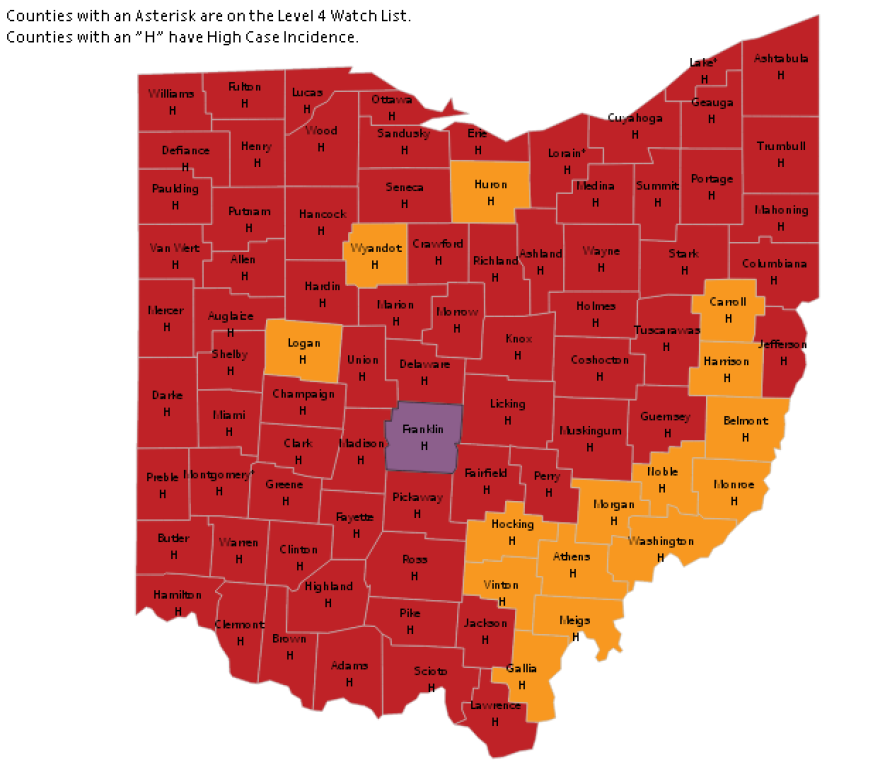Even with incomplete numbers caused by an overloaded system, the number of COVID-19 cases in Ohio continues to surge, and Franklin County has become the first in the state to hit the highest level on the state's public health advisory map.
State officials say Franklin County has reported at least 45,650 cases and 658 deaths, although that number will probably increase as the state works through a backlog of data. The county reports 553 cases per every 100,000 residents.
The purple Level 4 is defined as "severe exposure and spread", and people are asked to only leave home for supplies and services.
Ohio Governor Mike DeWine says there are no additional orders that accompany the classification, but that it is an indication of how serious the problem is. On Wednesday Columbus and County health officials called for a stay-at-home advisory to try and slow the documented spread of COVID in the community.
Hospitalizations have continued to skyrocket since September. At the peak this spring there were a little over 1,000 people in the hospital - that number is currently 3,829, with 943 people in intensive care units. Governor Mike Dewine turned the beginning of his regular coronavirus press conference over to some of the nurses and doctors who are facing the surge. Memorial Ohio Director of Clinical Eduation Erin Russo says for nurses "it feels like the finish line moves every month." While some compare the 8-month battle with COVID to a marathon, she says it's more like the Alaskan Iditarod.
"And honestly, the dogs are tired. Endurance is finite, and nurses are human. We can manufacture equipment and we can manufacture supplies, and we can create spaces to place beds and put people in. But what we can't manufacture is staff members that a skilled enough to care for those patients."
Nurse Cheryl Herbert, senior vice presidentof Ohio Health, says medical staff feels like they are standing in the path of a tsunami, as the increasing numbers of the more demanding COVID cases threaten to take space away from chronic conditions and emergency services. Herbert says that public measures to "flatten the curve" were successful this spring and summer, but that as the pandemic has dragged on, people's efforts have flagged and cases have surged.
"COVID patients require a much longer length of stay in the hospital, they get sicker. And health care workers have to spend more time on their care. All of that is really adding up to significant staff shortages and we find outrselves working throuhg those shortages on a shift-by-shift - and sometimes hour-by-hour basis, every single day."
DeWine also took time to respond to legislators who Thursday were prepared to vote on a bill that takes power away from the governor and the state health department to issue statewide public health orders. He says he has a "moral obligation" to veto the bill if it passes the Senate, to protect the flexibility of future officials.
"This bill would make Ohio slow to respond to a crisis. It would take tools away from this governor or future governors. It would put the lives of Ohioans in jeopardy. This bill.... is a disaster."
State health officials recorded 63 deaths from COVID-19, more than double the daily average of the past three weeks. They are also reporting 7,786 new cases in the past 24-hours, but caution for the second day in a row that those numbers are incomplete.
For the first time since the state launched it's coronavirus reporting site, health officials were unable to provide complete counts of cases Wednesday, and the counts remain incomplete. DeWine says that unlike some states, Ohio double checks the results of antigen tests before adding them to the daily count.
A month ago the state was conducting around 1,000 antigen tests a day - currently there are ten times that every day, and each must be checked individually. As of Monday there were 12,000 uncleared tests, and the number of new COVID cases is expected to grow retroactively.











